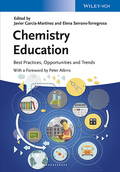Chemistry Education
Best Practices, Opportunities and Trends

1. Edition March 2015
XXXVIII, 754 Pages, Hardcover
300 Pictures (50 Colored Figures)
Monograph
Short Description
Adopting a practical approach, highly-experienced chemistry professors and chemistry education experts worldwide cover the latest developments in chemistry learning and teaching, as well as the pivotal role of chemistry in the modern world. A thorough review of this vibrant field
Buy now
Price: 219,00 €
Price incl. VAT, excl. Shipping
Euro prices for Wiley-VCH and Ernst & Sohn titles are only valid for Germany. In EU countries, local VAT applies. Postage will be charged.
This comprehensive collection of top-level contributions provides a thorough review of the vibrant field of chemistry education. Highly-experienced chemistry professors and education experts cover the latest developments in chemistry learning and teaching, as well as the pivotal role of chemistry for shaping a more sustainable future.
Adopting a practice-oriented approach, the current challenges and opportunities posed by chemistry education are critically discussed, highlighting the pitfalls that can occur in teaching chemistry and how to circumvent them. The main topics discussed include best practices, project-based education, blended learning and the role of technology, including e-learning, and science visualization.
Hands-on recommendations on how to optimally implement innovative strategies of teaching chemistry at university and high-school levels make this book an essential resource for anybody interested in either teaching or learning chemistry more effectively, from experience chemistry professors to secondary school teachers, from educators with no formal training in didactics to frustrated chemistry students.
#01 Chemistry Education and Human Activity
#02 Chemistry Education That Makes Connections: Our Responsibilities
#03 The Connection Between the Local Chemistry Curriculum and Chemistry Terms in the Global News: The Glocalization Perspective
#04 New Perspectives on the Undergraduate Chemistry Curriculum in Universities
#05 Empowering Chemistry Teachers? Learning: Practices and New Challenges
#06 Lifelong Learning: Approaches to Increasing the Understanding of Chemistry by Everybody
Part II Best Practices and Innovative Srategies
#07 Using Chemistry Education Research to Inform Teaching Strategies and Design of Instructional Materials
#08 Research on Problem Solving in Chemistry
#09 Do Real Work, not Homework
#10 Context-Based Learning on School and University Level
#11 Active Learning Pedagogies for the Future of Global Chemistry Education
#12 Inquiry-Based Student-Centered Instruction
#13 Flipping the Chemistry Classroom with Peer Instruction
#14 Innovative Community Learning Projects: from Chemical Reactions to Community Interactions
#15 The Role of Conceptual Integration in Understanding and Learning Chemistry
#16 Learner's Ideas, Misconceptions and Challenge
#17 The Role of Language in the Teaching and Learning of Chemistry
#18 Using the Cognitive Conflict Strategy with Classroom Chemistry Demonstrations
#19 Chemistry Education for Gifted Learners
#20 Experimental Experience through Project-Based Learning
#21 The Development of High-Order Learning Skills in High School Chemistry Laboratory: "Skills for Life"
#22 Chemistry Education through Microscale Experiments
Part III The Role of New Technologies
#23 21st Century Skills: Using the Web in Chemistry Education
#24 Design of Dynamic Visualizations to Enhance Conceptual Understanding in Chemistry Courses
#25 Chemistry Apps on Smartphones and Tablets
#26 E-Learning and Blended Learning in Chemistry Education
#27 Wiki Technologies and Communities: New Approaches to Assessing Individual and Collaborative Learning in the Chemistry Llaboratory
#28 New Tools and Challenges for Chemical Education: Mobile Learning, Augmented Reality and Distributed Cognition in the Dawn of the Social and Semantic Web
Elena Serrano-Torregrosa is a Research Fellow at the Molecular Nanotechnology Lab of the Inorganic Chemistry Department at the University of Alicante (Spain), where she has been teaching since 2009 and has created several courses on nanotechnology. She received her PhD in 2006 at the University of Basque Country, Spain (Iñaki Mondragón). After a post-doctoral activity at the National Institute of Applied Sciences, INSA in France (Jean-Pierre Pascault), Elena joined the Molecular Nanotechnology Lab at the University of Alicante in 2009. Her current research interests are in the area of new synthetic pathways to prepare photoactive hybrid titania-based materials, in which she is working for three years. Her last book is "The Chemical Element" (Wiley, 2011).


